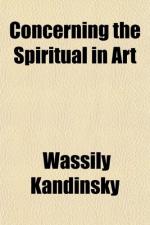In the case of light and dark colours the movement is emphasized. That of the yellow increases with an admixture of white, i.e., as it becomes lighter. That of the blue increases with an admixture of black, i.e., as it becomes darker. This means that there can never be a dark-coloured yellow. The relationship between white and yellow is as close as between black and blue, for blue can be so dark as to border on black. Besides this physical relationship, is also a spiritual one (between yellow and white on one side, between blue and black on the other) which marks a strong separation between the two pairs.
An attempt to make yellow colder produces a green tint and checks both the horizontal and excentric movement. The colour becomes sickly and unreal. The blue by its contrary movement acts as a brake on the yellow, and is hindered in its own movement, till the two together become stationary, and the result is green. Similarly a mixture of black and white produces gray, which is motionless and spiritually very similar to green.
But while green, yellow, and blue are potentially active, though temporarily paralysed, in gray there is no possibility of movement, because gray consists of two colours that have no active force, for they stand the, one in motionless discord, the other in a motionless negation, even of discord, like an endless wall or a bottomless pit.
Because the component colours of green are active and have a movement of their own, it is possible, on the basis of this movement, to reckon their spiritual appeal.
The first movement of yellow, that of approach to the spectator (which can be increased by an intensification of the yellow), and also the second movement, that of over-spreading the boundaries, have a material parallel in the human energy which assails every obstacle blindly, and bursts forth aimlessly in every direction.
Yellow, if steadily gazed at in any geometrical form, has a disturbing influence, and reveals in the colour an insistent, aggressive character. [Footnote: It is worth noting that the sour-tasting lemon and shrill-singing canary are both yellow.] The intensification of the yellow increases the painful shrillness of its note.
[Footnote: Any parallel between colour and music can only be relative. Just as a violin can give various shades of tone,—so yellow has shades, which can be expressed by various instruments. But in making such parallels, I am assuming in each case a pure tone of colour or sound, unvaried by vibration or dampers, etc.]
Yellow is the typically earthly colour. It can never have profound meaning. An intermixture of blue makes it a sickly colour. It may be paralleled in human nature, with madness, not with melancholy or hypochondriacal mania, but rather with violent raving lunacy.
The power of profound meaning is found in blue, and first in its physical movements (1) of retreat from the spectator, (2) of turning in upon its own centre. The inclination of blue to depth is so strong that its inner appeal is stronger when its shade is deeper.




